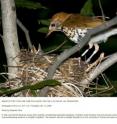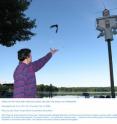Songbirds fly 3 times faster than expected
Related images
(click to enlarge)
A York University researcher has tracked the migration of songbirds by outfitting them with tiny geolocator backpacks – a world first – revealing that scientists have underestimated their flight performance dramatically. "Never before has anyone been able to track songbirds for their entire migratory trip," said study author Bridget Stutchbury, a professor of biology in York's Faculty of Science & Engineering. "We're excited to achieve this scientific first." Songbirds, the most common type of bird in our skies, are too small for conventional satellite tracking.
Stutchbury and her team mounted miniaturized geolocators on 14 wood thrushes and 20 purple martins, breeding in Pennsylvania during 2007, tracking the birds' fall takeoff, migration to South America, and journey back to North America. In the summer of 2008, they retrieved the geolocators from five wood thrushes and two purple martins and reconstructed individual migration routes and wintering locations.
Data from the geolocators indicated that songbirds can fly in excess of 500 km (311 miles) per day, reports Stutchbury in the Feb. 13 issue of the journal Science. Previous studies estimated their flight performance at roughly 150 km (93 miles) per day.
The study, funded in part by the National Geographic Society, found that songbirds' overall migration rate was two to six times more rapid in spring than in fall. For example, one purple martin took 43 days to reach Brazil during fall migration, but in spring returned to its breeding colony in only 13 days. Rapid long-distance movement occurred in both species, said Stutchbury.
"We were flabbergasted by the birds' spring return times. To have a bird leave Brazil on April 12 and be home by the end of the month was just astounding. We always assumed they left sometime in March," she said.
Researchers also found that prolonged stopovers were common during fall migration. The purple martins, which are members of the swallow family, had a stopover of three to four weeks in the Yucatan before continuing to Brazil. Four wood thrushes spent one to two weeks in the southeastern United States in late October, before crossing the Gulf of Mexico, and two other individuals stopped on the Yucatan Peninsula for two to four weeks before continuing migration.
The geolocators, which are smaller than a dime, detect light, allowing researchers to estimate birds' latitude and longitude by recording sunrise and sunset times. The devices are mounted on birds' backs by looping thin straps around their legs. The weight of the geolocator rests at the base of the bird's spine, so as not to interfere with its balance.
Stutchbury credits researchers with the British Antarctic Survey for miniaturizing the geolocators. "They hadn't really been thinking of [attaching them to] songbirds, but when I saw the technology, I knew we could do this," she said.
The study also uncovered evidence that wood thrushes from a single breeding population did not scatter over their tropical wintering grounds. All five wood thrushes wintered in a narrow band in eastern Honduras or Nicaragua.
"This region is clearly important for the overall conservation of wood thrushes, a species that has declined by 30 percent since 1966," said Stutchbury. "Songbird populations have been declining around the world for 30 or 40 years, so there is a lot of concern about them."
She emphasized the importance of this research not only to protect at-risk species of songbirds, but also to gauge environmental concerns.
"Tracking birds to their wintering areas is also essential for predicting the impact of tropical habitat loss and climate change," she said. "Until now, our hands have been tied in many ways, because we didn't know where the birds were going. They would just disappear and then come back in the spring. It's wonderful to now have a window into their journey."
Source: National Geographic Society
Other sources
- Faster Than a Speeding Songbirdfrom PopSci16 years ago
- Faster Than a Speeding Songbirdfrom PopSci16 years ago
- Songbirds Fly Three Times Faster Than Expectedfrom Science Daily16 years ago
- Tiny backpacks track songbird travelsfrom UPI16 years ago
- Tracking reveals songbirds' routefrom BBC News: Science & Nature16 years ago
- 'Amazing' songbird migration patternsfrom The Guardian - Science16 years ago
- Masters of flight: Songbirds make massive migration journey at top speedsfrom Scientific American16 years ago
- Migratory Songbird Mystery Solvedfrom National Geographic16 years ago
- Songbirds migrate faster than thoughtfrom MSNBC: Science16 years ago
- The Whole Migration and Nothing Butfrom Science NOW16 years ago
- Migrating songbirds get home fast in spring: studyfrom Reuters:Science16 years ago
- Tracking the Flight of Birds, With Tiny Backpacksfrom NY Times Science16 years ago
- Songbirds fly 3 times faster than expected (Video)from Physorg16 years ago



